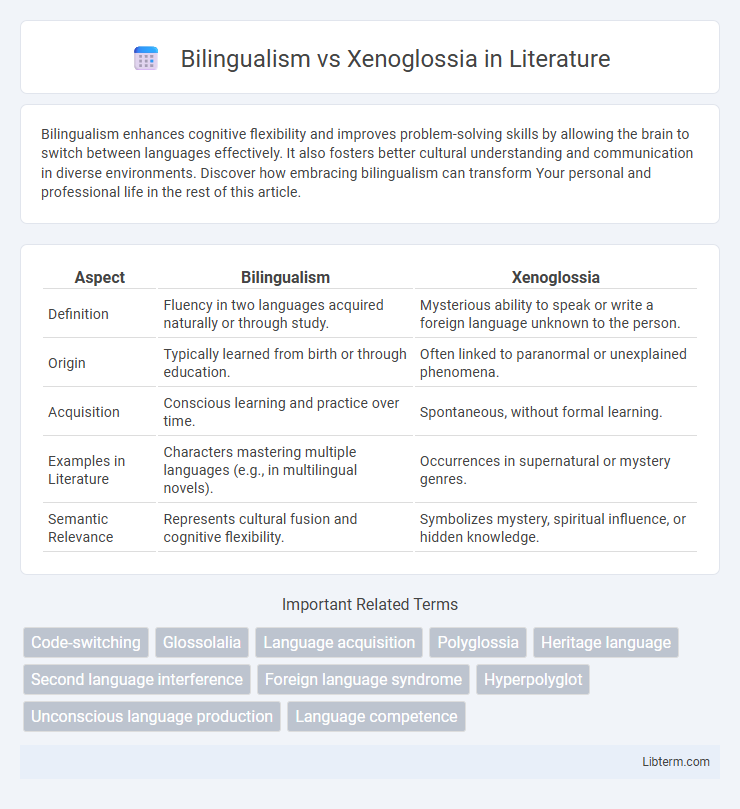Bilingualism enhances cognitive flexibility and improves problem-solving skills by allowing the brain to switch between languages effectively. It also fosters better cultural understanding and communication in diverse environments. Discover how embracing bilingualism can transform Your personal and professional life in the rest of this article.
Table of Comparison
| Aspect | Bilingualism | Xenoglossia |
|---|---|---|
| Definition | Fluency in two languages acquired naturally or through study. | Mysterious ability to speak or write a foreign language unknown to the person. |
| Origin | Typically learned from birth or through education. | Often linked to paranormal or unexplained phenomena. |
| Acquisition | Conscious learning and practice over time. | Spontaneous, without formal learning. |
| Examples in Literature | Characters mastering multiple languages (e.g., in multilingual novels). | Occurrences in supernatural or mystery genres. |
| Semantic Relevance | Represents cultural fusion and cognitive flexibility. | Symbolizes mystery, spiritual influence, or hidden knowledge. |
Introduction to Bilingualism and Xenoglossia
Bilingualism refers to the ability to fluently speak and understand two languages, typically acquired through regular exposure and practice in natural or educational settings. Xenoglossia, in contrast, describes the alleged phenomenon where an individual suddenly demonstrates knowledge of a language previously unknown to them, often without formal learning or exposure. While bilingualism is well-documented and studied within linguistics and cognitive science, xenoglossia remains controversial and largely unsupported by empirical evidence.
Defining Bilingualism: Natural Language Acquisition
Bilingualism refers to the natural acquisition and fluent use of two languages by an individual, typically developed through immersive exposure during early childhood or continuous practice in diverse linguistic environments. This process involves cognitive abilities like code-switching and language interference, supporting communication across varying cultural contexts. Unlike xenoglossia, which is claimed to be the sudden or spontaneous knowledge of a foreign language without prior learning, bilingualism is grounded in gradual, experiential language development and neuroplastic adaptation.
Understanding Xenoglossia: The Mystery of Unlearned Languages
Xenoglossia refers to the rare phenomenon where individuals speak or write in a language they have never learned, contrasting sharply with bilingualism, which involves fluency acquired through learning and practice. Unlike bilingualism, xenoglossia lacks linguistic immersion, formal study, or exposure, often raising questions in paranormal and linguistic research about its authenticity and origin. Scientific investigations into xenoglossia focus on psychological, neurological, and sociocultural explanations to demystify the occurrence of these unlearned languages.
Scientific Perspectives on Bilingualism
Scientific perspectives on bilingualism emphasize cognitive benefits such as enhanced executive function, improved memory, and greater mental flexibility resulting from proficiency in two or more languages. Neuroimaging studies reveal that bilingual brains exhibit increased gray matter density in the prefrontal cortex and better connectivity in language-processing regions, supporting superior multitasking and problem-solving skills. Unlike xenoglossia, which lacks empirical evidence and remains a controversial phenomenon, bilingualism is extensively researched and validated within linguistics and cognitive neuroscience.
Documented Cases of Xenoglossia
Documented cases of xenoglossia involve individuals speaking or understanding languages previously unknown to them without prior study, often cited in paranormal or supernatural contexts. Unlike bilingualism, which develops naturally through language learning and exposure, xenoglossia lacks linguistic acquisition evidence and is primarily reported in rare instances such as hypnosis, past-life regression, or spontaneous episodes. Scholarly research on xenoglossia remains limited, with cases often scrutinized for authenticity due to the absence of verifiable linguistic competency and the influence of psychological or situational factors.
Key Differences Between Bilingualism and Xenoglossia
Bilingualism involves the fluent use of two languages acquired through learning or environment, allowing effective communication and cultural understanding. Xenoglossia refers to the rare phenomenon of speaking or writing a language unknown to the individual by natural means, often attributed to paranormal or mystical experiences. The key difference lies in bilingualism's basis on learned skill versus xenoglossia's unexplained and involuntary language expression.
Cognitive Benefits and Challenges of Bilingualism
Bilingualism enhances cognitive flexibility, problem-solving skills, and executive function by enabling the brain to switch between languages and manage multiple linguistic systems simultaneously. Challenges include potential initial delays in vocabulary acquisition and occasional interference between languages, which can affect fluency and processing speed. Unlike bilingualism, xenoglossia involves spontaneous or inexplicable language usage without prior study, offering no established cognitive benefits but remains a controversial phenomenon in linguistics and psychology.
Skepticism and Controversy Surrounding Xenoglossia
Xenoglossia, the phenomenon where individuals purportedly speak or understand a language unknown to them, faces significant skepticism due to lack of empirical evidence and replication in controlled studies. Linguists and psycholinguists argue that many cases attributed to xenoglossia can be explained by subconscious learning, cryptomnesia, or fraud. In contrast, bilingualism is a well-documented cognitive ability involving proficiency in two languages acquired through natural learning processes, firmly supported by scientific research.
Social and Cultural Impacts of Bilingualism
Bilingualism enhances social integration by enabling individuals to engage meaningfully with diverse cultural groups, promoting empathy and reducing prejudice. It supports cognitive flexibility and cross-cultural communication skills, which are crucial in globalized societies. Unlike xenoglossia, which involves spontaneous language acquisition without prior learning and lacks everyday social relevance, bilingualism actively shapes identity and cultural exchange.
Future Research Directions: Bilingualism and Xenoglossia
Future research on bilingualism and xenoglossia should prioritize neurocognitive studies leveraging advanced imaging techniques to differentiate brain activity patterns associated with each phenomenon. Investigations into the genetic and environmental factors influencing bilingual language acquisition versus xenoglossia experiences can yield crucial insights into the underlying mechanisms. Longitudinal studies tracking language retention and neurological changes will help clarify whether xenoglossia represents a distinct linguistic capability or a rare psychological phenomenon.
Bilingualism Infographic

 libterm.com
libterm.com